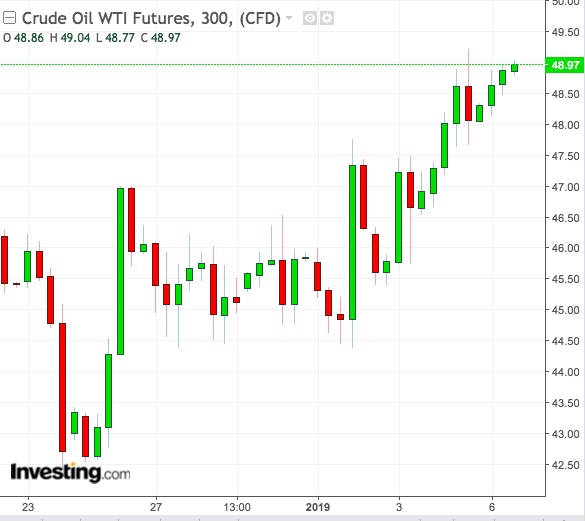US-Sino trade talks are likely to add to the bullish New Year fervor in oil, tipping US crude beyond the key $50 per barrel mark this week, while gold could stomp new ground in $1,300 territory from a potential slide in the dollar as the Fed signals it will be “patient” with rate hikes.
Soybeans and copper, two other commodities with gigantic demand in China, will also be taking their cue from the January 7-8 trade talks, the first since the December 1 meeting where US President Donald Trump and his Chinese counterpart Xi Jinping agreed upon a 90-day ceasefire.
In the case of crude, the meeting in Beijing will be another chance for oil bulls to prove global energy fundamentals are getting better after a disastrous 2018.
While the EU as a whole imports around 14 million barrels per day of crude, the single largest consuming nation for oil is China with about 8.4 million bpd. China’s economy, therefore, has major ramifications for global oil demand. China has said it expects the trade talks with US Deputy Trade Representative Jeffrey Gerrish and Treasury Undersecretary for International Affairs David Malpass to be “proactive and constructive.”
Encouraging 2019 Start For Oil
Oil has had an encouraging 2019 start from OPEC’s persistent message that it will deliver the 1.2 million bpd in production cuts promised with Russia over the next six months. OPEC lynchpin Saudi Arabia has also signaled its will to squeeze supplies as much as possible to recoup the 40 percent price drop from last year’s highs.
The stock market, which has determined oil price direction in the past three months as much as crude output and demand, might be on the side of oil bulls too. Fed Chair Jerome Powell said on Friday the central bank will assess the economy and the current low inflation regime before piling on rate hikes—an elixir for US stocks after one of their worst Christmases on record due, partly, to three rate increases.

The result has been a stronger-than-expected start for oil in the New Year, with US West Texas Intermediate crude tacking on a 6 percent gain in the first week. Friday’s intraday high of $49.22 for a barrel of WTI—before its settlement at $47.96—was 14 percent above the 18-month lows of $42.36 hit on Christmas Eve. As WTI enters its first full trading week of the year, there appears to be little hurdles between the market and a $50 test.
Dominick Chirichella, director of risk and trading at the Energy Management Institute in New York, is among those who believe a bottoming pattern has formed in both WTI and UK Brent crude since the Christmas Eve plunge.
But All Isn’t Well At The Oil Wells
But Chirichella is also skeptical of oil sustaining an even rally amid its mixed fundamentals now, saying “it is still too early to declare that the downtrend has reversed”, although he acknowledges signs suggesting “a change in direction.”
Analysts at Goldman Sachs weighed in more assertively, forecasting a 3-month and 6-month price of $62.50 and 67.50 respectively for Brent, versus their previous call of $70. They cite new pipelines that will release more cheap shale oil from the US Permian Basin, and slowing Chinese demand, among others.
The first contraction in 19 months in China’s Purchasing Managers Index (PMI) in December has strengthened economists’ belief that the world’s second largest economy is headed for a slowdown. And despite the feel-good vibe over the US-Sino talks, some say it’s premature to conclude that it’s a done deal. Any shift in China’s stance toward the trade talks would be volatile for equities and, consequently, crude prices.
Diverging Data Contradict Bullish Oil Story
The Chinese element aside, oil has just come off a dynamic week of diverging data. A Bloomberg survey early in the week suggested OPEC's December production had the largest month-on-month drop in almost two years.
But as the week was ending, the U.S. Energy Information Administration reported that domestic crude stockpiles barely fell in the final week of 2018, against a forecast drop of 3 million barrels. Gasoline inventories, meanwhile, jumped nearly 5 percent above the five-year average.
John Kilduff, founding partner at New York energy hedge Again Capital, said:
"I understand with the drop in post-holiday travel and trucking activity, some slowing demand is expected for (oil) products, but not to this extent. This is evidence of a slowing economy everyone's talking about, in the US at least, if not the world."
Gold’s Narrative More Solid
Gold’s bullish story is better grounded though.

Futures of the yellow metal crossed the much-awaited $1,300 per ounce target on Friday, triggering an equally anticipated profit-taking at the highs.
But with that breather, analysts expect gold bugs to advance into territory beyond $1,300 this week, encouraged by Powell’s “patient” stance on rate hikes.
Richmond Fed President Thomas Barkin provided more fuel for gold’s standing as a financial hedge when he said last week that he expected the US economy to grow more slowly in 2019, citing risks such as trade policy and financial market volatility.
Walter Pehowich, executive vice-president at Dillon Gage Metals in Addison, Texas, said fund managers without sizeable holdings in bullion were seriously considering SPDR Gold Shares (NYSE:GLD) and comparable ETFs. He added:
"The financial advisors we speak with continue to advise their clients to diversify part of their portfolios and invest in the gold market on a dollar cost averaging basis.”
